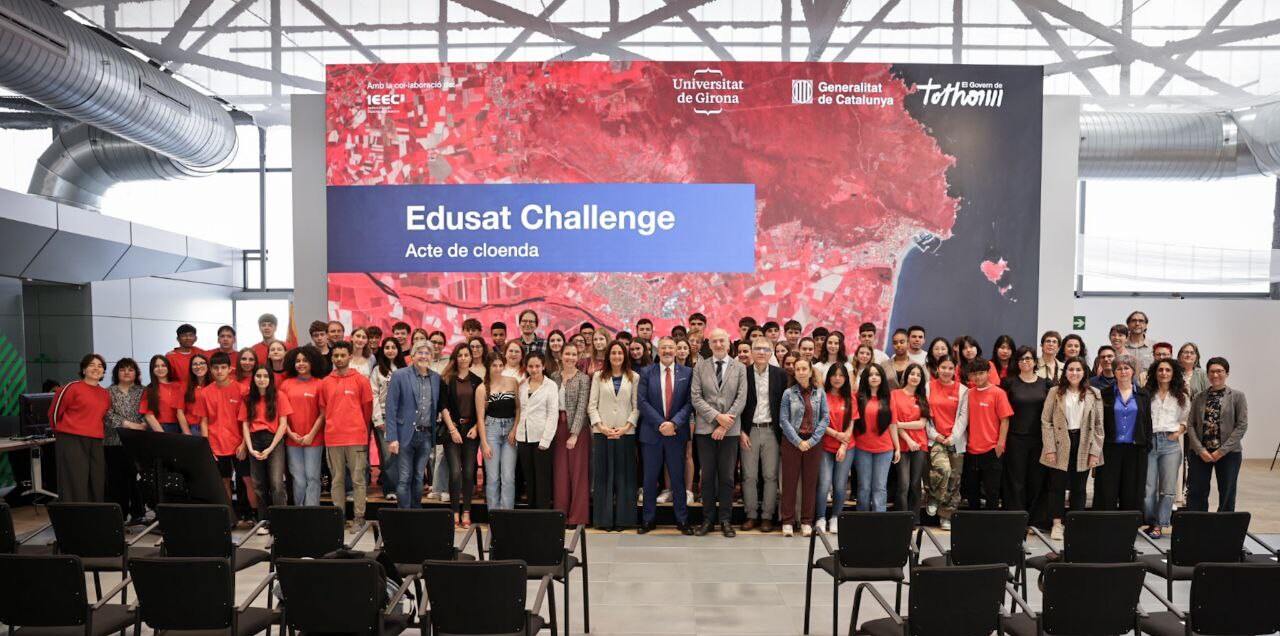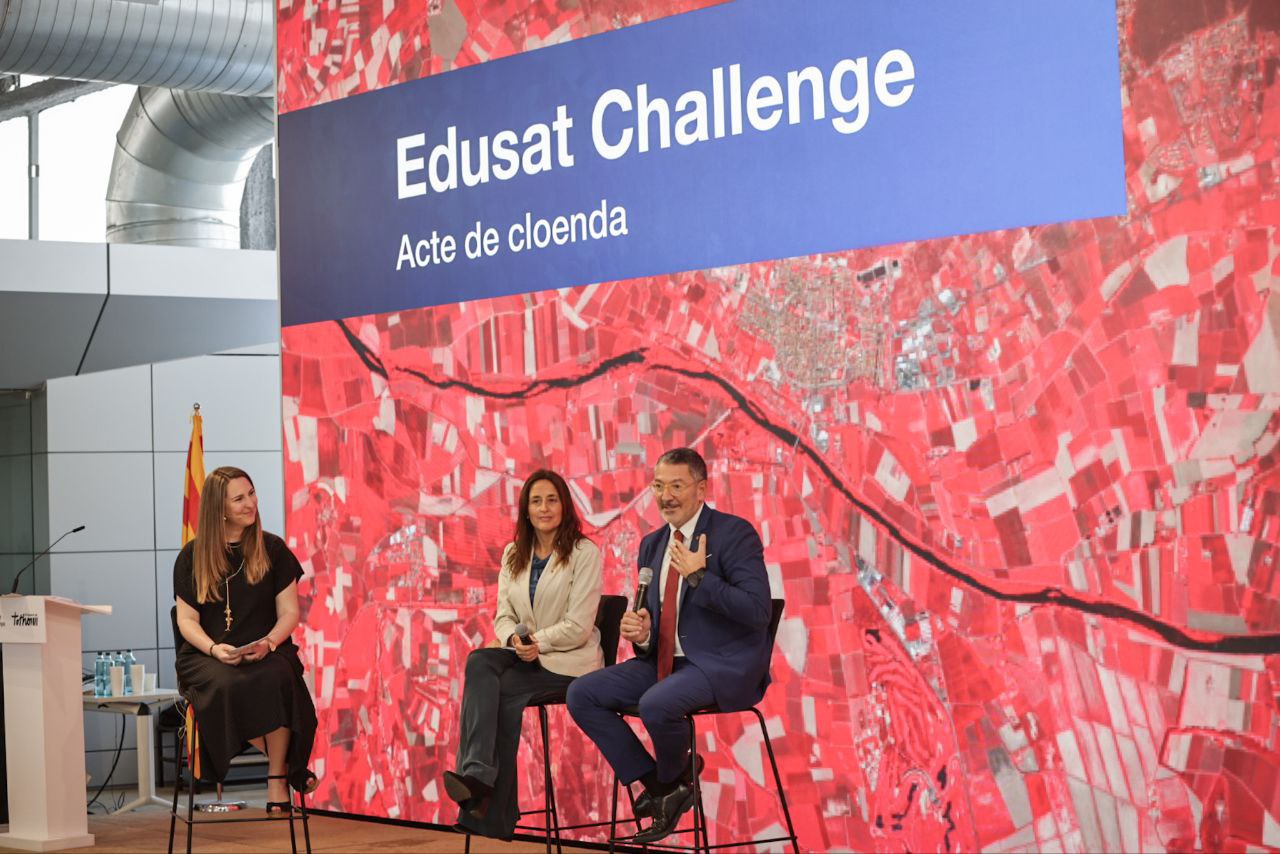More than 300 students and 23 teachers from across Catalonia successfully complete the Edusat Challenge, the program promoted by the Government to encourage scientific and technological vocations
• The Ministers of Business and Labour, Miquel Sàmper, and of Education and Vocational Training, Esther Niubó, presided over the closing ceremony of the program, where 65 students and 13 teachers from 8 of the participating centers presented the projects developed in the classrooms
• With Edusat Challenge, Earth Observation has been introduced in the classrooms of 20 educational centers through didactic proposals that make use of satellite images from the Copernicus program of the European Space Agency
• Driven by the Government within the framework of the NewSpace Strategy and the STEAMCat program, the Edusat Challenge originates from an initiative of the University of Girona and also counts on the collaboration of the Institute of Space Studies of Catalonia (IEEC)

More than 300 students and 23 teachers from high school, secondary school, and upper primary education across 20 educational centers throughout Catalonia have completed the first pilot year of the Edusat Challenge, the program promoted by the Government to introduce Earth Observation into the classrooms of schools and institutes. Today, they held the closing event and presentation of results at Espai Bital in L’Hospitalet de Llobregat.
The Minister of Business and Labor, Miquel Sàmper, and the Minister of Education and Vocational Training, Esther Niubó, presided over the event, which also included the participation of the Rector of the University of Girona (UdG), Quim Salvi, as well as the presence of the Secretary of Digital Policies, Maria Galindo, and the Director of the Area for the Promotion of the Space Sector at the Institute of Space Studies of Catalonia (IEEC), Josep Colomé.
Minister Sàmper highlighted the importance of a program like Edusat Challenge, “because it not only offers primary and secondary students the opportunity to explore and work with cutting-edge space technologies, but also involves training teachers in these new technologies.” “With this initiative, we are opening the doors to a sector and technology that until now have only been accessible to specialized research, and this helps generate scientific vocations and awaken interest in emerging digital technologies, thereby promoting future talent in fields such as New Space, which create quality jobs,” he added.
Councillor Niubó, for her part, highlighted that the Edusat Challenge is a good example of the coexistence between technology and learning “with purpose. That is, not only do we learn about technologies, but we use them to interpret data, apply concepts, solve problems, work as a team… This is where the impact can be truly transformative. Because, beyond knowing the tools, students develop skills that will serve them for life.” She also praised the “potential of space science to generate curiosity and a desire to learn” and the opportunity to address highly cross-cutting topics through the use of satellite images, which allow “connecting knowledge and disciplines” such as climate change, social sciences, and behavioral sciences.
For Rector Salvi, “the Edusat Challenge involves observing, listening to the stories that satellites tell us about the planet, and understanding what they want to convey, what information they provide. Detecting, staying alert, and acting accordingly.” “These are the key concepts that have been aimed to be extended within the educational field in schools and institutes throughout Catalonia,” he added.
About Edusat Challenge
The Edusat Challenge is a pilot program that offers training and support to teachers to introduce Earth observation into the classrooms of schools and institutes, with the ultimate goal of encouraging students’ interest in STEM (science, technology, engineering, and mathematics) and digital disciplines.
It is driven by the Departments of Business and Labour — through the Secretariat of Digital Policies — and Education and Vocational Training of the Government of Catalonia, within the framework of Catalonia’s NewSpace Strategy and the STEAMcat program, and is based on the Edusat platform developed by the Geographic Information Systems and Remote Sensing Service (SIGTE) of the University of Girona (UdG) to provide materials and training on remote sensing to university students and some schools for gifted students. The program also counts on the collaboration of the Institute of Space Studies of Catalonia (IEEC).

The program started in November of last year with an initial phase of teacher training so they could develop a teaching proposal based on the exploration and processing of satellite images related to the challenges of global environmental change, and bring it into the classrooms. In this training phase, 34 teachers from 31 centers across Catalonia participated.
In this first pilot year of the program, the theme around which the 40-hour training offer for participating teachers was structured is water and its management. They were encouraged to investigate case studies related to this theme, such as episodes of drought, floods, thawing, rivers, reservoirs, seas, and oceans around the world.
The program continued in January with the launch of the challenge and the implementation of an Earth observation activity in the classroom by the trained teachers, who have received mentoring and support throughout the process. This second phase of the program involved 23 of the initially trained teachers, who implemented their proposals in the classrooms of 20 educational centers across 11 counties in the four Catalan provinces.
Analysis in classrooms of the impact of climate change using satellite data
During the event, the councilors and other attendees had the opportunity to learn firsthand about the proposals developed in the classrooms of 8 of the participating schools in the Edusat Challenge. Around sixty students and 13 teachers from these schools presented live various projects analyzing the impact of climate change using satellite data from the Copernicus program of the European Space Agency (ESA):
- How to raise awareness through satellites? INS Escola del Treball (Lleida)
- Climate change-related phenomena studied through remote sensing. INS Joan Solà (Torrefarrera)
- DANÀLISI and Valencia underwater. INS Josefina Castellví i Piulachs (Viladecans)
- The water project. Mare Nostrum School (Tarragona)
- Evidence of causes and consequences of climate change. INS La Pobla de Segur (La Pobla de Segur)
- Tsunamis (Indonesia and Brazil). INS Ramon Turró i Darder (Malgrat de Mar)
- Sentinel, our eyes to observe water from space. Sagrat Cor Diputació (Barcelona)
- The unstoppable force of Cumbre Vieja. Escola Vedruna Tona (Tona)
Earth Observation via satellite to develop multiple competencies
Applied in educational centers, the Edusat Challenge program has allowed the development of competencies in the mathematical field (algebra, geometry, and statistics), as well as in the natural, social, and geographic fields (use and interpretation of maps and various data), in addition to enhancing digital, technological, teamwork, and critical data analysis skills.
Through the program, students have been able to identify and monitor various phenomena of interest that involve significant surface changes using satellite images from the Copernicus program of the European Space Agency (ESA). Copernicus is a European initiative that freely provides open, public, real-time data and images of our planet and environment thanks to the Sentinel satellites. These images allow the identification of natural phenomena such as wildfires, floods, glacier retreat, volcanic eruptions, or deforestation, both at local scales and anywhere around the world.
Thanks to the Edusat platform and the technological resources provided to the educational centers, it has been possible to observe from the classrooms the ongoing changes in the territory, such as the retreat of the Ebro Delta, the effects of river and stream flooding, the detection of various urban growth processes, and the monitoring of air pollution data in major cities, among others.
About the IEEC
The Institute of Space Studies of Catalonia (IEEC — Institut d’Estudis Espacials de Catalunya) promotes and coordinates space research and technology development in Catalonia for the benefit of society. IEEC fosters collaborations both locally and worldwide and is an efficient agent of knowledge, innovation and technology transfer. As a result of more than 25 years of high-quality research, done in collaboration with major international organisations, IEEC ranks among the best international research centres, focusing on areas such as: astrophysics, cosmology, planetary science, and Earth Observation. IEEC’s engineering division develops instrumentation for ground- and space-based projects, and has extensive experience in working with private or public organisations from the aerospace and other innovation sectors.
The IEEC is a non-profit public sector foundation that was established in February 1996. It has a Board of Trustees composed of the Generalitat de Catalunya, Universitat de Barcelona (UB), Universitat Autònoma de Barcelona (UAB), Universitat Politècnica de Catalunya · BarcelonaTech (UPC), and the Spanish Research Council (CSIC). The IEEC is also a CERCA centre.
